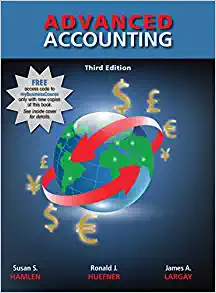Question
Assessment Tasks 8-1 A. Multiple Choice: Theory 1 1.Which of the following statement is false? a.The difference between list price and invoice price is equal
Assessment Tasks 8-1
A. Multiple Choice: Theory 1
1.Which of the following statement is false?
a.The difference between list price and invoice price is equal to the amount of the tradediscount.
b.Trade discounts are a convenient means of reducing list price to invoice price.
c.Trade discounts are not entered in the accounting records,d.Trade discounts are identical to cash discounts.
2.Revenue from the sale of merchandise should be entered in the accounting records at;
a.The list price,
b.The invoice price minus any cash discount
c.The list price minus any trade discount
d.The invoice price minus any trade discount and any cash discount.
3.Which of the following statement is false?
a.Cash discounts are a convenient means of reducing prices to invoice prices.
b.Cash discounts are used to encourage customers to make prompt discount payments.
c.From the seller's perspective, the terms "cash discount" and "sales discount" aresynonymous.
d.Cash discounts may be offered in conjunction with trade discounts.
4.The expression 3/20,n/60 means:
a.The invoice must be paid in 3 to 20 days, otherwise, interest for 60 days will be charged.
b.A 3% discount is available if the invoice is paid in 20 to 60 days; otherwise the totalinvoice price is due.
c.A 3% discount is available if the invoice is paid within 20 days, otherwise, the totalinvoice price is due in 60 days.
d.A 15% (3/4 of 20) is available if the invoice is paid within 60 days.
5.Revenue is normally entered in the accounting records when:
a.a customer orders goods
b.goods are received
c.a customer pays for the goods
d.goods are sold
6.In a merchandising operation, the Sales account should include
a.only credit sales of merchandise
b.only cash sales of merchandise
c.both cash and credit sales of merchandise
d.sales of both merchandise and other assets of the business.
7.DEF Co. had the following data for the period ended:
Cash salesP400,000
Credit sales280,000
Sales discounts25,000
Sales return20,000
Freight-in15,000
Freight-out16,000
DEF Co. would report net sale revenue on its statement of comprehensive income amounting to;
a.P635,000c.P620,000
b.P653,000d.P680,000
8.XYZ Company sold10 units f goods with a unit list price of P 2,000 on January 1, 2020. Given that the trade discount is 5%and the cash discount is 10% and that the cash discount period is 10 days and the credit period is 30 days, if the customer settles the debt on January 28, 2020, what is the actual amount he needs to pay?
a.P17,100c.P19,000
b.P18,050d.P20,000
9.A supplier offers the following discounts; Trade discount of 10% at list price andanother cash discount of 5% if paid in full before the due date. How much is to be paid ifa customer pays beforedue at a list price of P16,000?
a.P13,680c. P14,000
b.P15,520d. P16,000
10.A trade discount is:
a.shown in the sales journal,
b.shown in the purchase journal,
c.shown in the general journal,
d.not shown anywhere,
11.Which account does a merchandiser. but not a service entity use?a.Sales
b.Inventory
c.Cost of Goods Sold
d.All of the above
12.The two main inventory accounting systems are the following
a.purchase and sale,
b.returns and allowances.
c.cash and accrual.
d.perpetual and periodic.
13.Which of the following activities is not a component of the operating cycle?
a.Collection of cash from merchandise sales,
b.Ordering of merchandise,
c.Purchase of merchandise.
d.Sale of merchandise.
14.The periodic inventory system is used most commonly by companies that sell
a.high-priced, high-volume merchandise,
b.high-priced, low-volume merchandise, ,
c.low-priced, high-volume merchandise,
d.low-priced, low-volume merchandise,
15.A physical count of inventory is usually taken
a.at the end of the fiscal year,
b.at the peak of the busy season,
c.at the start of the fiscal year,
d.in the middle of the fiscal year,
16.A merchandiser will earn an operating income of exactly zero when
a.cost of goods sold equals gross margin,
b.gross margin equals operating expenses.
c.net sales equals cost of goods sold,
d.operating expenses equal net sales.
17.Gross margin equals the difference between net sales and
a.cost of goods sold.
b.cost of goods sold plus operating expenses,
c.operating expenses,
d.profit.
18.Which of the following goods would not be includedin merchandise inventory for purchasing entity?
a.Goods in transit shipped FOB destination
b.Goods in transit shipped FOB shipping pointc,Goods on hand in the showroomd, Goods ordered and received from the supplier
19.An amount deducted from the catalog price for an item of merchandise is called aa.customer discount,
b.purchases discount.
c,sales discount,d.trade discount.
20.Under the Perpetual inventory system, which of the following counts would not be used?a.Cost of Goods Sold
b.Merchandise Inventory
c.Purchases
d.Sales
Step by Step Solution
There are 3 Steps involved in it
Step: 1

Get Instant Access to Expert-Tailored Solutions
See step-by-step solutions with expert insights and AI powered tools for academic success
Step: 2

Step: 3

Ace Your Homework with AI
Get the answers you need in no time with our AI-driven, step-by-step assistance
Get Started


